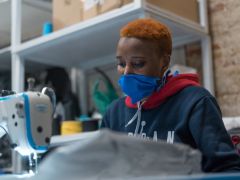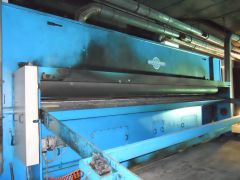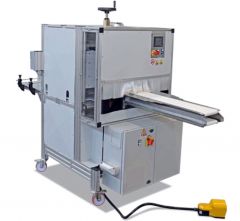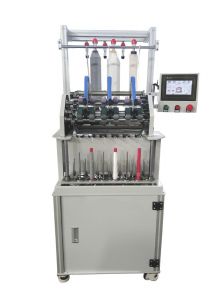Search results for: 'Pre need'
-
 D-2388 What’s the Best Material for a Mask?
D-2388 What’s the Best Material for a Mask?Federal health officials have now recommended that we cover our faces with fabric during the coronavirus pandemic. But what material offers the most protection?
The Centers for Disease Control and Prevention has posted a no-sew mask pattern using a bandanna and a coffee filter as well as a video on making masks using rubber bands and folded fabrics found at home.
While a simple face covering can reduce the spread of coronavirus by blocking outgoing germs from coughs or sneezes of an infected person, experts say there is more variation in how much homemade masks might protect the wearer from incoming germs, depending on the fit and quality of the material used.
Scientists around the country have taken it upon themselves to identify everyday materials that do a better job of filtering microscopic particles. In recent tests, HEPA furnace filters scored well, as did vacuum cleaner bags, layers of 600-count pillowcases and fabric similar to flannel pajamas. Stacked coffee filters had medium scores. Scarves and bandanna material had the lowest scores, but still captured a small percentage of particles.
If you don’t have any of the materials that were tested, a simple light test can help you decide whether a fabric is a good candidate for a mask.
“Hold it up to a bright light,” said Dr. Scott Segal, chairman of anesthesiology at Wake Forest Baptist Health who recently studied homemade masks. “If light passes really easily through the fibers and you can almost see the fibers, it’s not a good fabric. If it’s a denser weave of thicker material and light doesn’t pass through it as much, that’s the material you want to use.”
Researchers say it’s important to remember that lab studies are conducted under perfect conditions with no leaks or gaps in the mask, but the test methods give us a way to compare materials. And while the degree of filtration for some homemade masks seems low, most of us — who are staying home and practicing social distancing in public — don’t need the high level of protection required for medical workers. More important, any face covering is better than none, especially if worn by a person who has the virus but doesn’t know it.
The biggest challenge of choosing a homemade mask material is to find a fabric that is dense enough to capture viral particles, but breathable enough that we can actually wear it. Some items being touted online promise high filtration scores, but the material would be unwearable.
Dressing Up for Work … at Home
Yang Wang, an assistant professor of environmental engineering at Missouri University of Science and Technology, worked with his graduate students to study various combinations of layered materials — including both air filters and fabric. “You need something that is efficient for removing particles, but you also need to breathe,” said Dr. Wang, who last fall won an international award for aerosol research.To test everyday materials, scientists are using methods similar to those used to test medical masks, which everybody agrees should be saved for medical workers who are exposed to high doses of virus from seeing infected patients. The best medical mask — called the N95 respirator — filters out at least 95 percent of particles as small as 0.3 microns. By comparison, a typical surgical mask — made using a rectangular piece of pleated fabric with elastic ear loops — has a filtration efficiency ranging from 60 to 80 percent.
Dr. Wang’s group tested two types of air filters. An allergy-reduction HVAC filter worked the best, capturing 89 percent of particles with one layer and 94 percent with two layers. A furnace filter captured 75 percent with two layers, but required six layers to achieve 95 percent. To find a filter similar to those tested, look for a minimum efficiency reporting value (MERV) rating of 12 or higher or a microparticle performance rating of 1900 or higher.
The problem with air filters is that they potentially could shed small fibers that would be risky to inhale. So if you want to use a filter, you need to sandwich the filter between two layers of cotton fabric. Dr. Wang said one of his grad students made his own mask by following the instructions in the C.D.C. video, but adding several layers of filter material inside a bandanna.
Dr. Wang’s group also found that when certain common fabrics were used, two layers offered far less protection than four layers. A 600 thread count pillow case captured just 22 percent of particles when doubled, but four layers captured nearly 60 percent. A thick woolen yarn scarf filtered 21 percent of particles in two layers, and 48.8 percent in four layers. A 100 percent cotton bandanna did the worst, capturing only 18.2 percent when doubled, and just 19.5 percent in four layers.
The group also tested Brew Rite and Natural Brew basket-style coffee filters, which, when stacked in three layers, showed 40 to 50 percent filtration efficiency — but they were less breathable than other options.
If you are lucky enough to know a quilter, ask them to make you a mask. Tests performed at the Wake Forest Institute for Regenerative Medicine in Winston-Salem, N.C., showed good results for homemade masks using quilting fabric. Dr. Segal, of Wake Forest Baptist Health, who led the study, noted that quilters tend to use high-quality, high-thread count cotton. The best homemade masks in his study were as good as surgical masks or slightly better, testing in the range of 70 to 79 percent filtration. Homemade masks that used flimsier fabric tested as low as 1 percent filtration, Dr. Segal said.
The best-performing designs were a mask constructed of two layers of high-quality, heavyweight “quilter’s cotton,” a two-layer mask made with thick batik fabric, and a double-layer mask with an inner layer of flannel and outer layer of cotton.
Bonnie Browning, executive show director for the American Quilter’s Society, said that quilters prefer tightly woven cottons and batik fabrics that stand up over time. Ms. Browning said most sewing machines can handle only two layers of fabric when making a pleated mask, but someone who wanted four layers of protection could wear two masks at a time.
Ms. Browning said she recently reached out to quilters on Facebook and heard from 71 people who have made a combined total of nearly 15,000 masks. “We quilters are very much in the thick of what’s going on with this,” said Ms. Browning, who lives in Paducah, Ky. “One thing most of us have is a stash of fabric.”
People who don’t sew could try a folded origami mask, created by Jiangmei Wu, assistant professor of interior design at Indiana University. Ms. Wu, who is known for her breathtaking folded artwork, said she began designing a folded mask out of a medical and building material called Tyvek, as well as vacuum bags, after her brother in Hong Kong, where mask wearing is common, suggested it. (DuPont, the maker of Tyvek, said in a statement that Tyvek is intended for medical apparel, not masks.) The folded mask pattern is free online, as is a video demonstrating the folding process. In tests at Missouri University and University of Virginia, scientists found that vacuum bags removed between 60 percent and 87 percent of particles. But some brands of vacuum bags may contain fiberglass or are harder to breathe through than other materials, and shouldn’t be used. Ms. Wu used a bag by EnviroCare Technologies, which has said it does not use fiberglass in its paper and synthetic cloth bags.
“I wanted to create an alternative for people who don’t sew,” said Ms. Wu, who said she is talking to various groups to find other materials that will be effective in a folded mask. “Given the shortage of all kinds of materials, even vacuum bags might run out.”
The scientists who conducted the tests used a standard of 0.3 microns because that is the measure used by the National Institute for Occupational Safety and Health for medical masks.
Linsey Marr, a Virginia Tech aerosol scientist and an expert in the transmission of viruses, said the certification method for respirators and HEPA filters focuses on 0.3 microns because particles around that size are the hardest to catch. While it seems counterintuitive, particles smaller than 0.1 microns are actually easier to catch because they have a lot of random motion that makes them bump into the filter fibers, she said.
“Even though coronavirus is around 0.1 microns, it floats around in a wide range of sizes, from around 0.2 to several hundred microns, because people shed the virus in respiratory fluid droplets that also contain lots of salts and proteins and other things,” said Dr. Marr. “Even if the water in the droplets fully evaporates, there’s still a lot of salt and proteins and other gunk that stays behind as solid or gel-like material. I think 0.3 microns is still useful for guidance because the minimum filtration efficiency will be somewhere around this size, and it’s what NIOSH uses.”
Learn More -
 M-1519 NONWOVEN PRODUCTION LINE WIDTH 7000mm YEAR 2004
M-1519 NONWOVEN PRODUCTION LINE WIDTH 7000mm YEAR 2004M-1519 NONWOVEN PRODUCTION LINE WIDTH 7000mm YEAR 2004
OFFER 001
MASIAS HOPPER FEEDEROFFER 002
MASIAS CARDING MACHINEOFFER 003
PRE-NEEDLE LOOMOFFER 004
FINISH NEEDLE LOOMOFFER 005
AUTOMATEX ACCUMULATOROFFER 007
AUTOMATEX LONGITUDINAL AND CROSS CUTTERQUANTITY: 1 LINE
Learn More -
 X-0008 ELECTRONICALLY CONTROLLED SEMI-AUTOMATIC FILLING FOR PILLOW, CUSHIONS, QUILTS, BABY MATTRESSES AND MOREREFERENCE NUMBER: X-0008 ELECTRONICALLY CONTROLLED SEMI-AUTOMATIC FILLING FOR PILLOW, CUSHIONS, QUILTS, BABY MATTRESSES AND MORE THIS MACHINE IS A STAND-ALONE AND VERY VERSATILE PILLOW STUFFING AND BAGGING MACHINE. ITS SIMPLE OPERATION ALLOWS TO USE THE SAME EQUIPMENT TO ACCOMPLISH THE TWO PROCESSES: STUFFING A BATT OR A FOAM CORE IN A COVER (OR AN INSERT IN THE FINAL DEC COVER / A PILLOW IN THE FINAL ZIPPERED COVER) AND/OR PUT A FINISHED PILLOW IN A BAG (INDIVIDUAL PE BAG, TWIN-PACK BAG, ZIPPERED VINYL BAG, ETC). THE MACHINE CAN BE LOADED MANUALLY OR WITH A CONVEYOR ON THE REAR PART, WHILE AN OPERATOR IS NEEDED IN THE FRONT: HE PUTS THE COVER/BAG ONTO THE STUFFING BELTS, ACTIVATES THE TENSIONING FORKS WITH THE PEDAL AND HOLDING THE COVER/BAG FACILITATES THE PILLOW STUFFING. POWER SUPPLY IS 400 VOLTS, WILL NEED A TRANSFORMER TO OPERATE ON 480 VOLTS, INQUIRE IF NEEDED Learn More
X-0008 ELECTRONICALLY CONTROLLED SEMI-AUTOMATIC FILLING FOR PILLOW, CUSHIONS, QUILTS, BABY MATTRESSES AND MOREREFERENCE NUMBER: X-0008 ELECTRONICALLY CONTROLLED SEMI-AUTOMATIC FILLING FOR PILLOW, CUSHIONS, QUILTS, BABY MATTRESSES AND MORE THIS MACHINE IS A STAND-ALONE AND VERY VERSATILE PILLOW STUFFING AND BAGGING MACHINE. ITS SIMPLE OPERATION ALLOWS TO USE THE SAME EQUIPMENT TO ACCOMPLISH THE TWO PROCESSES: STUFFING A BATT OR A FOAM CORE IN A COVER (OR AN INSERT IN THE FINAL DEC COVER / A PILLOW IN THE FINAL ZIPPERED COVER) AND/OR PUT A FINISHED PILLOW IN A BAG (INDIVIDUAL PE BAG, TWIN-PACK BAG, ZIPPERED VINYL BAG, ETC). THE MACHINE CAN BE LOADED MANUALLY OR WITH A CONVEYOR ON THE REAR PART, WHILE AN OPERATOR IS NEEDED IN THE FRONT: HE PUTS THE COVER/BAG ONTO THE STUFFING BELTS, ACTIVATES THE TENSIONING FORKS WITH THE PEDAL AND HOLDING THE COVER/BAG FACILITATES THE PILLOW STUFFING. POWER SUPPLY IS 400 VOLTS, WILL NEED A TRANSFORMER TO OPERATE ON 480 VOLTS, INQUIRE IF NEEDED Learn More -
 M-0180 AUTOMATIC VACUUM PILLOW MACHINE 001EREFERENCE NUMBER: M-0180 AUTOMATIC VACUUM PILLOW MACHINE 001E RAW MATERIAL & CASE FABRIC MATERIAL APPLICATION: FOR CONJUGATE HOLLOW SILICONIZED POLYESTER FIBER SHORTER THAN 100mm MICRO FIBER SHORTER THAN 100mm ELASTIC FIBER SHORTER THAN 100mm PILLOW FABRIC QUALITY: PERMEABLE FABRIC LENGTH: 13 METERS LONG QUANTITY AVAILABLE: 1 Learn More
M-0180 AUTOMATIC VACUUM PILLOW MACHINE 001EREFERENCE NUMBER: M-0180 AUTOMATIC VACUUM PILLOW MACHINE 001E RAW MATERIAL & CASE FABRIC MATERIAL APPLICATION: FOR CONJUGATE HOLLOW SILICONIZED POLYESTER FIBER SHORTER THAN 100mm MICRO FIBER SHORTER THAN 100mm ELASTIC FIBER SHORTER THAN 100mm PILLOW FABRIC QUALITY: PERMEABLE FABRIC LENGTH: 13 METERS LONG QUANTITY AVAILABLE: 1 Learn More -
 F-1228 EPS MOLDING PRODUCTION LINE FOR BOX/CONTAINER/TRAY WITH THREE MOLDSREFERENCE NUMBER: F-1228 EPS MOLDING PRODUCTION LINE FOR BOX/CONTAINER/TRAY WITH THREE MOLDS (NEW) CONSIST OF: 1. EPS BATCH PRE-EXPANDER TYPE SJ1100 2. AUTOMATIC SHAPE MOLDING MACHINE WITH VACUUM SZ172 3. EPS MOULD FOR SZ172 MOLDING MACHINE 4. AUXILIARY EQUIPMENT QUANTITY AVAILABLE: 1 Learn More
F-1228 EPS MOLDING PRODUCTION LINE FOR BOX/CONTAINER/TRAY WITH THREE MOLDSREFERENCE NUMBER: F-1228 EPS MOLDING PRODUCTION LINE FOR BOX/CONTAINER/TRAY WITH THREE MOLDS (NEW) CONSIST OF: 1. EPS BATCH PRE-EXPANDER TYPE SJ1100 2. AUTOMATIC SHAPE MOLDING MACHINE WITH VACUUM SZ172 3. EPS MOULD FOR SZ172 MOLDING MACHINE 4. AUXILIARY EQUIPMENT QUANTITY AVAILABLE: 1 Learn More -
 F-1227 EPS BLOCK (6000×1200×600mm) PRODUCTIONREFERENCE NUMBER: F-1227 EPS BLOCK (6000×1200×600mm) PRODUCTION LINE (NEW) CONSIST OF: 1. EPS BATCH PRE-EXPANDER MODEL SJ1400 2. EPS AUTO AIR-COOLING BLOCK MOLDING MACHINE SB6000 3. EPS CUTTING MACHINE PSC6000 4. CNC CUTTING MACHINE SCS3000 5. AUTO SHAPE MOLDING MACHINE WITH VACUUM SZ-172 6. AUXILIARY EQUIPMENT QUANTITY AVAILABLE: 1 Learn More
F-1227 EPS BLOCK (6000×1200×600mm) PRODUCTIONREFERENCE NUMBER: F-1227 EPS BLOCK (6000×1200×600mm) PRODUCTION LINE (NEW) CONSIST OF: 1. EPS BATCH PRE-EXPANDER MODEL SJ1400 2. EPS AUTO AIR-COOLING BLOCK MOLDING MACHINE SB6000 3. EPS CUTTING MACHINE PSC6000 4. CNC CUTTING MACHINE SCS3000 5. AUTO SHAPE MOLDING MACHINE WITH VACUUM SZ-172 6. AUXILIARY EQUIPMENT QUANTITY AVAILABLE: 1 Learn More -
 TT-5852 MASCOTT PLUS 25-30 CROSSLAPPER AND MONO_1AB_27-3000 NEEDLE LOOMTT-5852 MASCOTT PLUS 25-30 CROSSLAPPER AND MONO_1AB_27-3000 NEEDLE LOOM Learn More
TT-5852 MASCOTT PLUS 25-30 CROSSLAPPER AND MONO_1AB_27-3000 NEEDLE LOOMTT-5852 MASCOTT PLUS 25-30 CROSSLAPPER AND MONO_1AB_27-3000 NEEDLE LOOM Learn More -
 TT-4823 TRUETZSCHLER AUTOMATEX NONWOVEN NEEDLELOOMS, WORKING WIDTH 7000mm, YEAR 2002TT-4823 TRUETZSCHLER AUTOMATEX NONWOVEN NEEDLELOOMS, WORKING WIDTH 7000mm, YEAR 2002 ITEM 001 TANDEM NEEDLELOOM BRAND: AUTOMATEX MODEL AG 80 T/BA QUANTITY: 1 ITEM 002 PRENEEDLER BRAND: AUTOMATEX MODEL PR 50/T QUANTITY: 1 Learn More
TT-4823 TRUETZSCHLER AUTOMATEX NONWOVEN NEEDLELOOMS, WORKING WIDTH 7000mm, YEAR 2002TT-4823 TRUETZSCHLER AUTOMATEX NONWOVEN NEEDLELOOMS, WORKING WIDTH 7000mm, YEAR 2002 ITEM 001 TANDEM NEEDLELOOM BRAND: AUTOMATEX MODEL AG 80 T/BA QUANTITY: 1 ITEM 002 PRENEEDLER BRAND: AUTOMATEX MODEL PR 50/T QUANTITY: 1 Learn More -
 TT-1389 LAB RING SPINNING FRAMETT-1389 LAB RING SPINNING FRAME KEY SPECIFICATION: CONTROL MODE: TOUCH SCREEN & PLC NUMBER OF SPINDLES: 6 APPLICABLE FIBER LENGTH: 22 TO 50mm DRAFT RANGE: 10 TO 50 DRAFT CONTROL: AUTOMATIC ROLLER DIAMETER: FRONT ROLLER: Φ25mm, MIDDLE ROLLER: Φ25mm BACK ROLLER: Φ25mm CENTER DISTANCE OF ROLLERS: FRONT AND MIDDLE: 43mm FRONT AND BACK: 143mm PRESSURE MODE: SPRING CRADLE TWIST SETTABLE RANGE: 200 TO 2,000 TWIST/M RING DIAMETER: RING NOT NEEDED IF THERE IS NO NEED FOR TWISTING FUNCTION. THIS MACHINE WILL USE A SHAFT TO MOVE THE YARN UP AND DOWN TO WIND ON THE PIRN TOTAL KW: 1.5 KW VOLTAGE: 220 VOLTS, 3-PHASE, 60 Hz WEIGHT: 650 KG DIMENSIONS: 1750 x 760 x 1950mm SPINDLE SPEED: 3800 RPM QUANTITY: 1 SET Learn More
TT-1389 LAB RING SPINNING FRAMETT-1389 LAB RING SPINNING FRAME KEY SPECIFICATION: CONTROL MODE: TOUCH SCREEN & PLC NUMBER OF SPINDLES: 6 APPLICABLE FIBER LENGTH: 22 TO 50mm DRAFT RANGE: 10 TO 50 DRAFT CONTROL: AUTOMATIC ROLLER DIAMETER: FRONT ROLLER: Φ25mm, MIDDLE ROLLER: Φ25mm BACK ROLLER: Φ25mm CENTER DISTANCE OF ROLLERS: FRONT AND MIDDLE: 43mm FRONT AND BACK: 143mm PRESSURE MODE: SPRING CRADLE TWIST SETTABLE RANGE: 200 TO 2,000 TWIST/M RING DIAMETER: RING NOT NEEDED IF THERE IS NO NEED FOR TWISTING FUNCTION. THIS MACHINE WILL USE A SHAFT TO MOVE THE YARN UP AND DOWN TO WIND ON THE PIRN TOTAL KW: 1.5 KW VOLTAGE: 220 VOLTS, 3-PHASE, 60 Hz WEIGHT: 650 KG DIMENSIONS: 1750 x 760 x 1950mm SPINDLE SPEED: 3800 RPM QUANTITY: 1 SET Learn More -
 T-7954 SAMHWA NEEDLE PUNCHING MACHINE UPSTROKE, WIDTH 3950mm, YEAR 2017T-7954 SAMHWA NEEDLE PUNCHING MACHINE UPSTROKE, WIDTH 3950mm, YEAR 2017 PRESENT STATUS: FULLY FUNCTIONAL QUANTITY: 1 Learn More
T-7954 SAMHWA NEEDLE PUNCHING MACHINE UPSTROKE, WIDTH 3950mm, YEAR 2017T-7954 SAMHWA NEEDLE PUNCHING MACHINE UPSTROKE, WIDTH 3950mm, YEAR 2017 PRESENT STATUS: FULLY FUNCTIONAL QUANTITY: 1 Learn More
